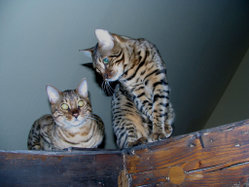

Custom Search
|

| Bengal |
|---|
| Country of origin |
| United States |
| Breed standards (external links) |
| ACFA, TICA, CCA, ACF, FIFe, GCCF |
The Bengal cat is a relatively new breed of domestic housecat (felis catus) developed to have a gentle and friendly temperament, while exhibiting facial coloration patterns and body coat patterns (such as spots and rosettes) reminiscent of the wild Asian Leopard cat, felis bengalensis. Put another way, a bengal cat desirably has 'wild' coat characteristics and coloration with a gentle domestic cat temperament.
Bengals are medium sized cats - a male may weigh as much as 20 lb (9 kg), and a female commonly weighs 7 to 12 lb (4 to 6 kg.) Male cats are generally larger than females.
Bengal cats are a hybrid developed over many generations through a program of rigorous crossbreeding, hybridizing domestic cats with desired coat and temperament features with Asian Leopard Cats (ALC) and ALC hybrids. The principle of hybrid vigor dictates that hybrid cats are often larger than either parent, but are typically infertile. F1 and F2 males are nearly always infertile, F3 males are normally infertile, but females are often fertile even in early hybrids.
A cat with one wild ancestor is called an F1, short for first filial. An F1 bred with a domestic cat or other bengal filial cat yields an F2, or second filial. Any kittens from an F2 female are termed F3. Any kittens from an F3 female are termed F4. F4 and higher generations are officially known as Stud Book Tradition (SBT) bengals and can be shown and registered. Any SBT bengal is at least four generations from the wild. It is worth noting that the offspring of an F2 and an SBT is an F3, not an SBT. This labelling, although somewhat complex, should be irrelevant to a prospective bengal owner. Lower filial cats (F1-F3) are typically termed foundation cats and are best reserved for breeding purposes.
Any bengal cat offered for sale should be an F4 or higher hybrid. Although some specialty breeders occasionally sell lower filial number (F1-F3) cats, their temperament is not easily predicted and undersocialised low generation cats can be skittish, retiring and not easily housebroken. The ALC is a solitary, small, shy and reclusive cat not known for interacting with humans. The purpose of crossbreeding them with domestic cats was to obtain a wild-appearing cat with a desirable friendly personality and gentle temperament.
The modern SBT bengal genepool contains genes sourced from many varieties of domestic cats - mainly Egyptian Maus, American Shorthair, Abyssinian, Ocicat, and domestic shorthaired cats. It is commonly accepted that the breed was developed by Jean Mill of California in the 1970's, although bengal breeders exist throughout the world today. Many breeders today are working to develop specific characteristics in the breed, often by backcrossing foundation cats with particularly vivid markings. The wild Asian Leopard Cat has considerable variation in markings throughout the world.
Bengal cats are either spotted or have marbled patterns on their coats. Spots with multiple colors, or ringed spots are particularly desired. The following colors and patterns are recognized: Brown Spotted Tabby, Brown Marbled Tabby, Seal Sepia Spotted Tabby, Seal Sepia Marbled Tabby, Seal Mink Spotted Tabby, Seal Mink Marbled Tabby, Seal Spotted Lynx Point and Seal Marbled Lynx Point only. Silver Spotted, Silver Marbled and Melanistic (black) are additional colors and patterns not yet recognized by all breeding associations that accept the Bengal cat.
Bengal cats can take a great deal of interest in running water and often don't mind getting wet. Most Bengal owners have stories about their cat's affection for running water or even jumping in a sink or tub. Additionally, Bengal cats are very intelligent and curious, and so are particularly interactive with their human housemates, wanting to be in the middle of whatever the human is engaged in, and often following the human around the house as household chores are performed. Bengals tend to vocalize to communicate with their humans, and are quite capable of jealousy and spitefulness if they feel that another feline is getting more attention. The other side of this coin is that they are also extremely affectionate towards and playful with their humans. Excellent hearing and highly developed instincts make Bengal cats excellent watch dogs.
 Two male Bengal Cats.
Two male Bengal Cats.
In February 1998, an F2 Bengal cat named Cato made the guinness world records by being the most expensive cat purchased. It was bought for $41,435.00 (USD) by Cindy Jackson of London, England (Jackson herself also a record holder for having had the most cosmetic procedures). The Bengal cat was sold by breeder Lord C. Esmond Gay of Bedfordshire, England. Note however, that as of 2005, this Bengal cat is no longer the world record holder.
There are currently two new varieties of cats being developed from the Bengal:
Cats, made by MultiMedia | Free content and software
This guide is licensed under the GNU Free Documentation License. It uses material from the Wikipedia.